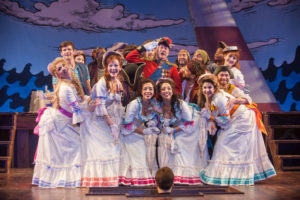In today’s Wall Street Journal drama column I review a Massachusetts production of The Pirates of Penzance. Here’s an excerpt.
* * *
 Rejoice greatly! John Rando and Joshua Bergasse, whose 2013 Barrington Stage revival of “On the Town” moved to Broadway the following year and ran for 368 performances, have joined forces again: Barrington Stage has reunited the best of all possible director-choreographer teams for a rumbustious production of “The Pirates of Penzance” that is strongly cast, delightfully designed and whizzingly well-staged. It’s no less worthy of a New York transfer than “On the Town,” and I wouldn’t be surprised if one is in the works.
Rejoice greatly! John Rando and Joshua Bergasse, whose 2013 Barrington Stage revival of “On the Town” moved to Broadway the following year and ran for 368 performances, have joined forces again: Barrington Stage has reunited the best of all possible director-choreographer teams for a rumbustious production of “The Pirates of Penzance” that is strongly cast, delightfully designed and whizzingly well-staged. It’s no less worthy of a New York transfer than “On the Town,” and I wouldn’t be surprised if one is in the works.
Should this “Pirates” make it to Broadway, it’ll be none too soon. The comic operettas of Gilbert and Sullivan are not-so-distant ancestors of the modern-day American musical, yet they’re rarely revived in this country by professional theater troupes. I’ve reviewed just two productions in the past 13 years, and it’s been three decades since an operetta by G & S (as they’re known to their avid fans) was last mounted on Broadway. It is, alas, all too easy to see why. Not only is “The Mikado,” their masterpiece, now widely regarded as politically incorrect, but Sullivan wrote his scores for classically trained singers, meaning that when the operettas do get done professionally, it increasingly tends to be by opera companies like Chicago’s Lyric Opera….
This helps to explain why only one G & S operetta has had a long commercial run on Broadway. In 1980, the Public Theater commissioned William Elliott to revise “The Pirates of Penzance” to make Sullivan’s score more suitable for performance by musical-comedy actors and Broadway-sized pit bands. The resulting production, which starred Kevin Kline and Linda Ronstadt, opened to immensely successful effect in Central Park, then played for two years on Broadway, after which it was filmed. No other G & S production has reached a larger audience.
It stands to reason, then, that Barrington Stage should have opted to produce Elliott’s version of “Pirates” in its 520-seat mainstage theater. Beowulf Borritt’s comic-strip set features a runway that juts straight out into the auditorium—the mainmast of the ship on which the first act takes place dead center in the house—and Mr. Rando has filled both aisles to overflowing with actors. The effect is noisily intimate: If you’re sitting on the aisle or in one of the two stage boxes, you’re more than likely to have pirates in your face at one time or another, and you might even get pulled out of your seat to take part in the action. Mr. Rando, a recognized master of slapstick, keeps the energy level vaultingly high, and Mr. Bergasse’s choreography is irresistibly ludicrous….
* * *
Read the whole thing here.
The finale from the Public Theater’s 1980 Central Park production of The Pirates of Penzance, directed by Wilford Leach and starring Kevin Kline, Linda Ronstadt, and George Rose:


